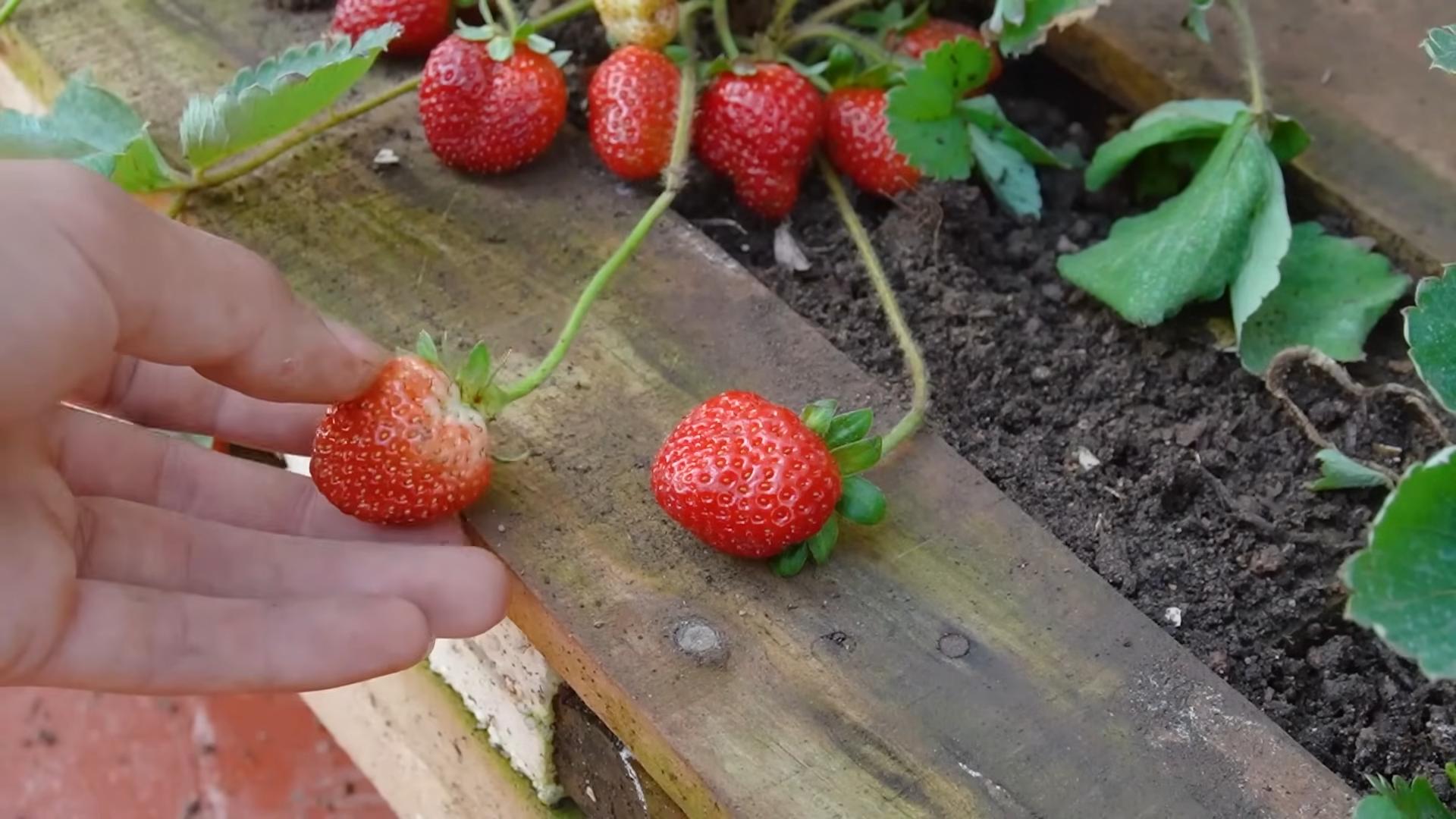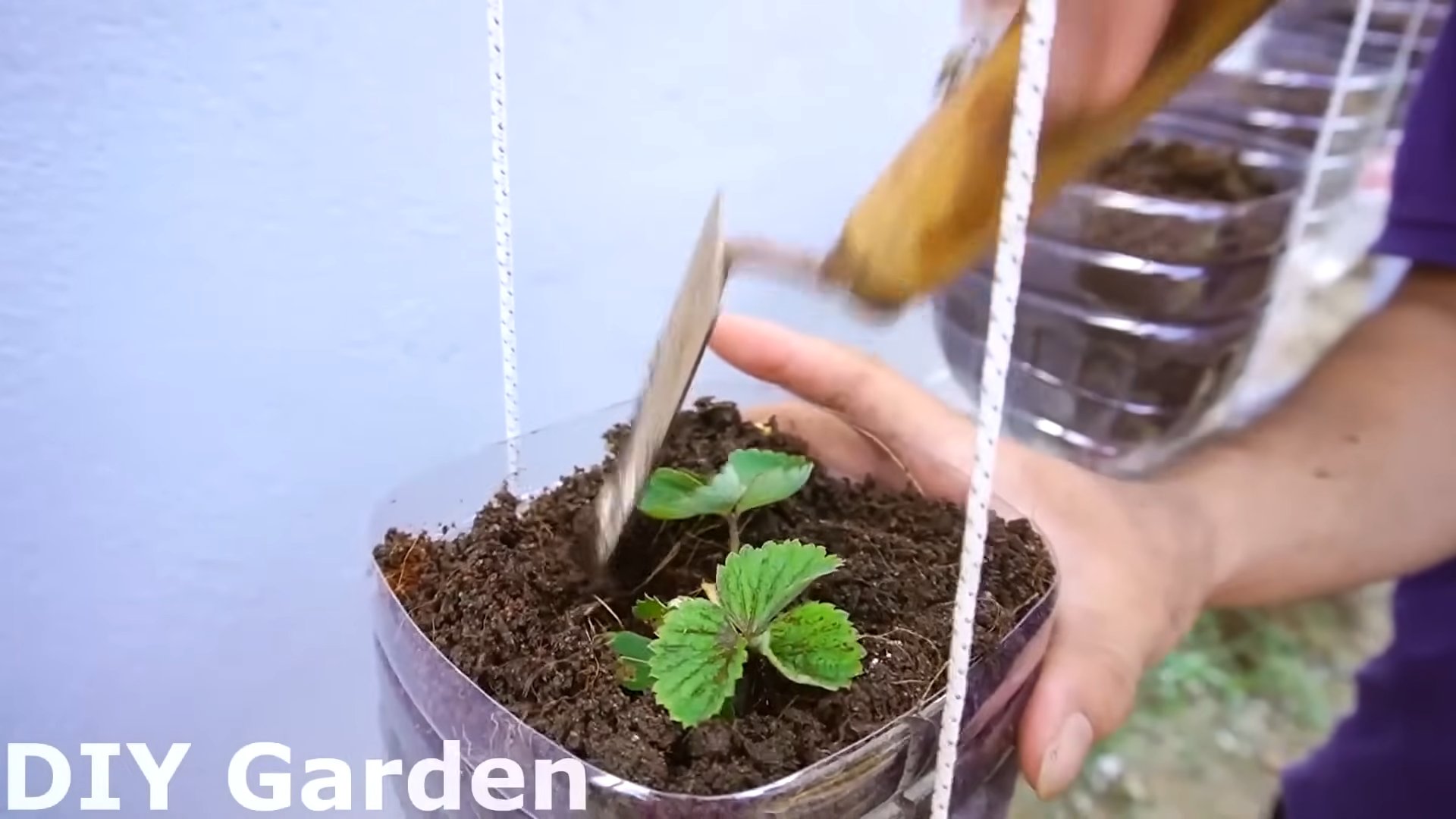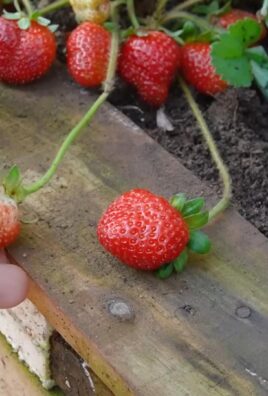Strawberry growing tricks – who doesn’t love the taste of a sun-ripened, juicy strawberry, bursting with flavor? I know I do! But what if I told you that you could have a constant supply of these delicious berries, fresh from your own garden, without breaking the bank or spending hours toiling away?
For centuries, strawberries have been cherished not only for their taste but also for their vibrant color and symbolism. From ancient Roman gardens to medieval monastery plots, these little red gems have held a special place in our hearts and diets. But let’s be honest, sometimes growing them can feel like a battle against pests, diseases, and unpredictable weather.
That’s where these DIY strawberry growing tricks come in! I’m going to share some simple, yet incredibly effective, hacks that will transform your strawberry patch from a struggling disappointment into a thriving berry bonanza. Whether you’re a seasoned gardener or just starting out, these tips will help you maximize your yield, minimize your effort, and enjoy the sweetest, most flavorful strawberries you’ve ever tasted. So, grab your gardening gloves, and let’s dive into the world of strawberry growing tricks that will have you picking bowls full of deliciousness in no time!

Grow the Sweetest Strawberries Ever: My DIY Secrets!
Hey there, fellow gardening enthusiasts! I’m so excited to share my tried-and-true methods for growing the juiciest, most flavorful strawberries you’ve ever tasted. Forget those bland, store-bought berries – we’re talking about homegrown goodness that will blow your mind! I’ve spent years experimenting, and I’ve finally perfected a system that works wonders. Get ready to transform your garden into a strawberry paradise!
Choosing the Right Strawberry Variety
Before we even get our hands dirty, it’s crucial to pick the right strawberry variety for your climate and preferences. Trust me, this makes a HUGE difference!
* June-Bearing Strawberries: These are your classic, one-big-harvest-per-year kind of berries. They produce a large crop, usually in late spring or early summer (hence the name!). If you want to make a big batch of jam or freeze a bunch for later, these are a great choice. Some popular June-bearing varieties include ‘Chandler,’ ‘Honeoye,’ and ‘Earliglow.’
* Everbearing Strawberries: Don’t let the name fool you – they don’t produce berries *constantly*. Instead, they give you two or three harvests throughout the growing season, typically in spring, summer, and fall. They’re perfect if you want a steady supply of strawberries for snacking or adding to your morning cereal. ‘Ozark Beauty’ and ‘Seascape’ are reliable everbearing options.
* Day-Neutral Strawberries: These are the most consistent producers, offering a continuous harvest from spring through fall. They’re less sensitive to day length than other varieties, making them a great choice for areas with shorter growing seasons. ‘Albion’ and ‘San Andreas’ are popular day-neutral varieties.
Consider your local climate and growing conditions when making your choice. Check with your local nursery or extension office for recommendations on the best varieties for your area.
Preparing the Perfect Strawberry Bed
Strawberries are pretty adaptable, but they thrive in well-drained, slightly acidic soil. Here’s how I prepare my strawberry beds for maximum success:
* Sunlight: Strawberries need at least 6-8 hours of direct sunlight per day. Choose a location that gets plenty of sunshine.
* Soil: Strawberries prefer well-drained soil with a pH between 5.5 and 6.5. If your soil is heavy clay or sandy, amend it with plenty of organic matter, such as compost or well-rotted manure.
* Weed Control: Strawberries don’t compete well with weeds, so it’s essential to eliminate them before planting. You can use a pre-emergent herbicide, hand-pull weeds, or cover the area with black plastic or landscape fabric for a few weeks to kill existing weeds.
* Raised Beds (Optional): I highly recommend growing strawberries in raised beds, especially if you have heavy clay soil. Raised beds improve drainage and allow the soil to warm up faster in the spring.
Planting Your Strawberry Plants
Now for the fun part – planting! Here’s my step-by-step guide:
1. Soak the Roots: Before planting, soak the roots of your strawberry plants in water for about 30 minutes. This will help them rehydrate and get off to a good start.
2. Dig the Holes: Dig holes that are large enough to accommodate the roots of the plants without crowding them. Space the plants about 12-18 inches apart in rows that are 3-4 feet apart.
3. Planting Depth: This is crucial! Make sure the crown of the plant (the point where the roots meet the stem) is level with the soil surface. Planting too deep can cause the crown to rot, while planting too shallow can dry out the roots.
4. Spread the Roots: Gently spread the roots out in the hole before backfilling with soil.
5. Water Thoroughly: After planting, water the plants thoroughly to settle the soil and help them establish.
Watering and Fertilizing for Strawberry Success
Consistent watering and proper fertilization are key to a bountiful strawberry harvest.
* Watering: Strawberries need consistent moisture, especially during fruit development. Water deeply and regularly, especially during dry spells. Avoid overhead watering, as this can promote fungal diseases. Drip irrigation is ideal.
* Fertilizing: Fertilize your strawberry plants in early spring, after the first flush of growth. Use a balanced fertilizer, such as 10-10-10, or a fertilizer specifically formulated for berries. Avoid over-fertilizing, as this can lead to excessive foliage growth and fewer berries. I also like to side-dress my plants with compost tea every few weeks for an extra boost of nutrients.
Mulching for Weed Control and Moisture Retention
Mulch is your best friend when it comes to growing strawberries!
* Benefits of Mulch: Mulch helps to suppress weeds, retain moisture, and regulate soil temperature. It also helps to keep the berries clean by preventing them from touching the soil.
* Types of Mulch: I prefer to use organic mulches, such as straw, pine needles, or shredded leaves. These mulches decompose over time, adding nutrients to the soil. You can also use black plastic or landscape fabric, but these materials don’t provide the same benefits as organic mulches.
* Application: Apply a 2-3 inch layer of mulch around your strawberry plants, being careful not to cover the crowns.
Dealing with Pests and Diseases
Strawberries are susceptible to a few common pests and diseases, but with a little vigilance, you can keep them under control.
* Slugs and Snails: These slimy critters love to munch on strawberry leaves and berries. You can control them by hand-picking them off the plants, using slug bait, or creating barriers with copper tape or diatomaceous earth.
* Birds: Birds can be a major problem, especially when the berries are ripening. Protect your plants with netting or bird repellent.
* Gray Mold (Botrytis): This fungal disease can cause the berries to rot. Prevent it by providing good air circulation, avoiding overhead watering, and removing any infected berries promptly.
* Leaf Spot: This fungal disease causes brown spots on the leaves. Prevent it by providing good air circulation and avoiding overhead watering. You can also treat it with a fungicide if necessary.
Harvesting Your Delicious Strawberries
This is the moment you’ve been waiting for!
* When to Harvest: Strawberries are ready to harvest when they are fully red and slightly soft to the touch. They should also detach easily from the plant.
* How to Harvest: Gently grasp the berry and twist it off the plant, leaving a small piece of the stem attached.
* Storage: Store your freshly harvested strawberries in the refrigerator. They’re best eaten within a few days.
Extending the Strawberry Season
Want to enjoy strawberries for even longer? Here are a few tips:
* Row Covers: Use row covers to protect your plants from frost in the spring and fall. This can help you get an earlier start and extend the harvest season.
* Succession Planting: Plant different varieties of strawberries that ripen at different times. This will give you a longer, more consistent harvest.
* Cold Frames or Greenhouses: If you’re really serious about extending the season, consider growing strawberries in a cold frame or greenhouse.
Propagating New Strawberry Plants
Strawberries are easy to propagate, so you can easily expand your strawberry patch.
* Runners: Strawberries produce runners, which are horizontal stems that grow along the ground. These runners will develop roots and form new plants.
* Rooting Runners: To propagate new plants, simply pin the runners to the ground with a U-shaped pin or rock. Once the roots have developed, you can cut the runner from the mother plant and transplant the new plant to a new location.
* Division: You can also propagate strawberries by dividing established plants. In the spring or fall, carefully dig up the plant and divide it into several smaller plants, each with its own roots.
My Secret Weapon: Companion Planting
Companion planting is a fantastic way to boost your strawberry crop naturally! Here are some of my favorite strawberry companions:
* Borage: This beautiful herb attracts beneficial insects and is said to improve the flavor of strawberries.
* Marigolds: Marigolds repel nematodes and other soil pests.
* Garlic and Onions: These pungent plants deter aphids and other insects.
* Thyme: Thyme repels cabbage moths and other pests.
* Lettuce and Spinach: These leafy greens provide ground cover and help to suppress weeds.
Troubleshooting Common Strawberry Problems
Even with the best care, you might encounter a few problems along the way. Here’s how to troubleshoot some common issues:
* Small Berries: Small berries can be caused by a lack of water, nutrients, or

Conclusion
So, there you have it! These simple yet effective strawberry growing tricks are your secret weapon to unlocking a bountiful harvest of sweet, juicy strawberries right in your own backyard, balcony, or even windowsill. Forget those bland, overpriced berries from the grocery store. Imagine sinking your teeth into a sun-ripened strawberry, bursting with flavor, knowing you nurtured it from tiny seedling to delicious fruit. That’s the magic of growing your own, and these tips make it easier than ever before.
We’ve covered everything from optimizing sunlight and soil conditions to warding off pests and diseases with natural solutions. Remember the importance of well-draining soil to prevent root rot, and how mulching not only suppresses weeds but also helps retain moisture and keep those precious berries clean. Don’t underestimate the power of companion planting; basil and marigolds are your strawberry plants’ best friends!
But the beauty of gardening lies in experimentation. Feel free to adapt these strawberry growing tricks to your specific environment and preferences. For instance, if you live in a particularly hot climate, consider providing some afternoon shade to prevent sunscald. If space is limited, vertical gardening with hanging baskets or stacked planters is a fantastic option. You could even try different varieties of strawberries to find your absolute favorite – some are sweeter, some are larger, and some are more resistant to certain diseases. Everbearing varieties will give you multiple harvests throughout the season, while June-bearing varieties provide a single, abundant crop.
Consider experimenting with different types of mulch. While straw is a classic choice, pine needles can add acidity to the soil, which strawberries love. Just be sure to avoid using grass clippings that have been treated with herbicides.
And don’t forget about feeding your plants! A balanced fertilizer specifically formulated for berries will provide them with the nutrients they need to thrive. You can also supplement with organic amendments like compost tea or fish emulsion.
The key is to observe your plants closely and adjust your approach as needed. Are the leaves turning yellow? Are the berries small and pale? These are signs that something might be amiss, and a little detective work can help you identify and address the problem.
Ultimately, growing strawberries is a rewarding experience that connects you with nature and provides you with a delicious and healthy treat. It’s a project that the whole family can enjoy, from planting the seeds to harvesting the fruits of your labor.
So, what are you waiting for? Grab your gardening gloves, gather your supplies, and get ready to embark on your strawberry-growing adventure. We’re confident that with these tips, you’ll be enjoying a bumper crop of delicious strawberries in no time.
We’d love to hear about your experiences! Share your successes, your challenges, and your own unique strawberry growing tricks in the comments below. Let’s create a community of strawberry enthusiasts and learn from each other. Happy growing!
Frequently Asked Questions (FAQ)
Q: What is the best time of year to plant strawberries?
A: The best time to plant strawberries depends on your climate and the type of strawberry you’re planting. In general, early spring (as soon as the ground can be worked) or late fall (after the first frost) are ideal. Spring planting allows the plants to establish themselves before the heat of summer, while fall planting gives them a head start on root development before winter dormancy. For June-bearing varieties, spring planting is often preferred. For everbearing and day-neutral varieties, either spring or fall planting can work well. Consider your local climate and growing season when making your decision.
Q: What kind of soil is best for growing strawberries?
A: Strawberries thrive in well-draining, slightly acidic soil with a pH between 5.5 and 6.5. The soil should be rich in organic matter. Before planting, amend the soil with compost, well-rotted manure, or other organic amendments to improve drainage, fertility, and water retention. Avoid heavy clay soils, as they can lead to root rot. If you have clay soil, consider growing strawberries in raised beds or containers. A soil test can help you determine the pH and nutrient levels of your soil and guide you in making necessary amendments.
Q: How much sunlight do strawberries need?
A: Strawberries need at least 6-8 hours of direct sunlight per day to produce a good crop of berries. More sunlight is generally better, especially for everbearing varieties. If you live in a hot climate, providing some afternoon shade can help prevent sunscald. Choose a planting location that receives plenty of sunlight throughout the day.
Q: How often should I water my strawberry plants?
A: Strawberries need consistent moisture, especially during flowering and fruiting. Water deeply and regularly, aiming to keep the soil consistently moist but not waterlogged. The frequency of watering will depend on your climate, soil type, and the age of your plants. Check the soil moisture regularly by sticking your finger into the soil about an inch deep. If it feels dry, it’s time to water. Avoid overhead watering, as it can promote fungal diseases. Drip irrigation or soaker hoses are ideal for delivering water directly to the roots.
Q: How do I protect my strawberries from pests and diseases?
A: There are several ways to protect your strawberries from pests and diseases. Companion planting with basil or marigolds can help deter pests. Use row covers or netting to protect the berries from birds and other animals. Regularly inspect your plants for signs of pests or diseases, such as aphids, spider mites, or fungal spots. Remove any infected leaves or berries promptly. Use organic pest control methods, such as insecticidal soap or neem oil, to control pests. Ensure good air circulation around your plants to prevent fungal diseases. Choose disease-resistant varieties of strawberries.
Q: When should I fertilize my strawberry plants?
A: Fertilize your strawberry plants in early spring, before they start to flower, and again after the first harvest. Use a balanced fertilizer specifically formulated for berries, following the instructions on the package. Avoid over-fertilizing, as this can lead to excessive foliage growth and fewer berries. You can also supplement with organic amendments like compost tea or fish emulsion.
Q: How do I prune my strawberry plants?
A: Pruning strawberries depends on the type of strawberry you are growing. For June-bearing varieties, after the harvest is complete, mow or cut back the foliage to about an inch above the crown. This will encourage new growth and prepare the plants for winter dormancy. For everbearing and day-neutral varieties, remove runners regularly to encourage the plants to focus their energy on producing berries. You can also remove any dead or diseased leaves throughout the growing season.
Q: How do I overwinter my strawberry plants?
A: In cold climates, protect your strawberry plants from freezing temperatures by mulching them heavily with straw or pine needles. This will insulate the roots and prevent them from being damaged by frost. You can also cover the plants with row covers or burlap. In milder climates, mulching may be sufficient. Remove the mulch in early spring, after the last frost, to allow the plants to start growing again.
Q: Can I grow strawberries in containers?
A: Yes, strawberries grow very well in containers. Choose a container that is at least 12 inches deep and wide, with good drainage holes. Use a well-draining potting mix amended with compost. Container-grown strawberries will need more frequent watering and fertilizing than those grown in the ground. Place the container in a sunny location.
Q: How long does it take for strawberry plants to produce fruit?
A: The time it takes for strawberry plants to produce fruit depends on the type of strawberry and the planting time. June-bearing varieties typically produce fruit the following spring after planting. Everbearing and day-neutral varieties may produce some fruit in the first year, but the main harvest will be in the second year. Be patient and provide your plants with the care they need, and you’ll be rewarded with a delicious harvest.




Leave a Comment